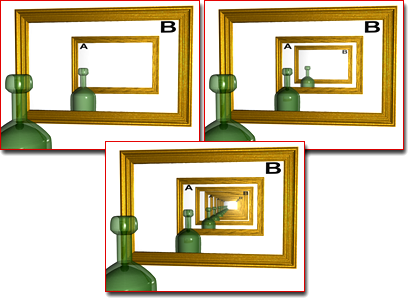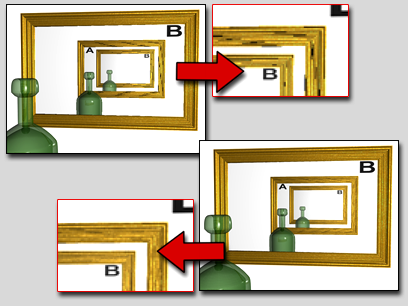These parameters control the raytracer globally. That is, they affect all Raytrace materials and Raytrace maps in your scene. They also affect the generation of Advanced Ray-traced shadows and Area shadows.
Interface

Ray Depth Control group
Ray depth, also known as recursion depth, controls how many times the renderer allows a ray to bounce before it is considered lost or trapped.

Upper left: Ray depth is zero.
Upper right: Ray depth of 2.
Lower middle: Extremely high ray depth
- Maximum Depth
- Sets the maximum recursion depth. Increasing this value potentially increases the realism of your rendered scene, at a cost of rendering time. You can reduce this value to reduce rendering time. Range=0 to 100. Default=9.
- Cutoff Threshold
- Sets a cutoff threshold for adaptive ray levels. If the contribution of any ray to the final pixel color drops below the cutoff threshold, the ray is terminated. Default: 0.05 (5% of the final pixel color). This can speed up your rendering time considerably.
- Color to use at Max Depth
- As a rule, when a ray reaches the maximum depth, it is rendered the same color as the background environment. You can override the color returned at maximum depth by either selecting a color, or setting an alternative environment map. This can make the "lost" ray invisible in the scene. Tip: If you are having trouble with getting complex objects to render, especially glass, specify the maximum recursion color to something obvious, like magenta, and your background color to something that contrasts, like cyan. The chances are that a lot of your rays are getting lost in either maximum recursion or just being shot off into the world, totally missing anything you think they should strike. Try rendering the scene again. If this is the problem, try reducing the Maximum Depth value.
- Specify Specifies what color the raytracer returns when the ray is considered lost or trapped. Click the color swatch to change this color.
- Background (The default.) Returns the background color when the ray is considered lost or trapped. For Raytrace material, the background color is the global environment background or the environment specified locally for the material. For Raytrace map, the background color is either the global environment background, or is set locally in the Raytracer Parameters rollout.
Global Ray Antialiaser group
Controls in this group let you set global antialiasing for raytraced maps and materials. To use global antialiasing, first click the On checkbox to enable the setting, then choose the antialiaser from the drop-down list.

Above: No antialiasing.
Below: Antialiasing of reflections
- On
- When on, uses antialiasing. Default=off.
- [drop-down list]
-
Chooses which antialiasing settings to use. There are two options:
- Fast Adaptive Antialiaser Uses the Fast Adaptive antialiaser globally.
Click ... to open the Fast Adaptive Antialiaser dialog.
- Multiresolution Adaptive Antialiaser Uses the Multiresolution Adaptive antialiaser globally.
Click ... to open the Multiresolution Adaptive Antialiaser dialog.
- Multiresolution Adaptive Antialiaser Uses the Multiresolution Adaptive antialiaser globally.
- Fast Adaptive Antialiaser Uses the Fast Adaptive antialiaser globally.
Global Raytrace Engine Options group
These options are comparable to the local options on Extended Parameters rollout and the Raytracer Controls rollout. Their setting affects all Raytrace materials and Raytrace maps in the scene, unless you set local overrides.
- Enable Raytracing
- Turns the raytracer on or off. Default=on.
Even with raytracing off, Raytrace material and Raytrace map still reflect and refract the environment, including both the environment map for the scene, and the environment map assigned to the Raytrace material.
- Raytrace Atmospherics
- Turns the raytracing of atmospheric effects on or off. Atmospheric effects include fire, fog, volume light, and so on. Default=on.
- Enable Self Reflect/Refract
- Turns self reflection/refraction on or off. Default=on.
Can an object reflect itself? For example, a teapot's body reflects the teapot's handle, but a sphere will never reflect itself. If you don't need this effect, you can improve render time by turning off this toggle.
Tip: If you have a transparent object such as glass, and Enable Self Reflect/Refract is on, you don't have to make the object 2-sided. The raytracer sees back faces when exiting refractive objects. - Reflect/Refract Material IDs
- When on, the material reflects effects assigned to material IDs in the renderer's G-buffer on or off. Default=on.
By default, Raytrace material and Raytrace map reflect effects assigned to a material's ID, so that G-buffer effects are not lost. For example, if a raytraced object reflects a lamp made to glow with the Video Post Glow filter (Lens Effects Glow), the reflection glows as well.
- Render objects inside raytraced objects
- Toggles the rendering of objects inside raytraced objects. Default=on.
- Render atmospherics inside raytraced objects
- Toggles the rendering of atmospheric effects inside raytraced objects. Atmospheric effects include fire, fog, volume light, and so on. Default=on.
- Enable Color Density / Fog Effects
- Toggles the color density and fog features.
- Acceleration Controls
- Opens the Raytracing Acceleration Parameters dialog.
- Exclude
- Opens the Raytrace Exclude/Include dialog, which lets you exclude objects from ray-tracing.
- Show Progress Dialog
- When on, rendering displays a window with progress bars titled Raytrace Engine Setup. Default=on.
- Show Messages
- When on, displays a window, Raytrace Messages, that shows status and progress messages from the raytrace engine. Default=off.
- Reset
- Click to restore settings to their default values.